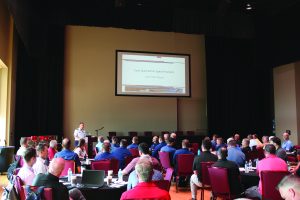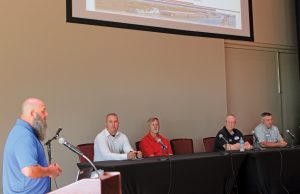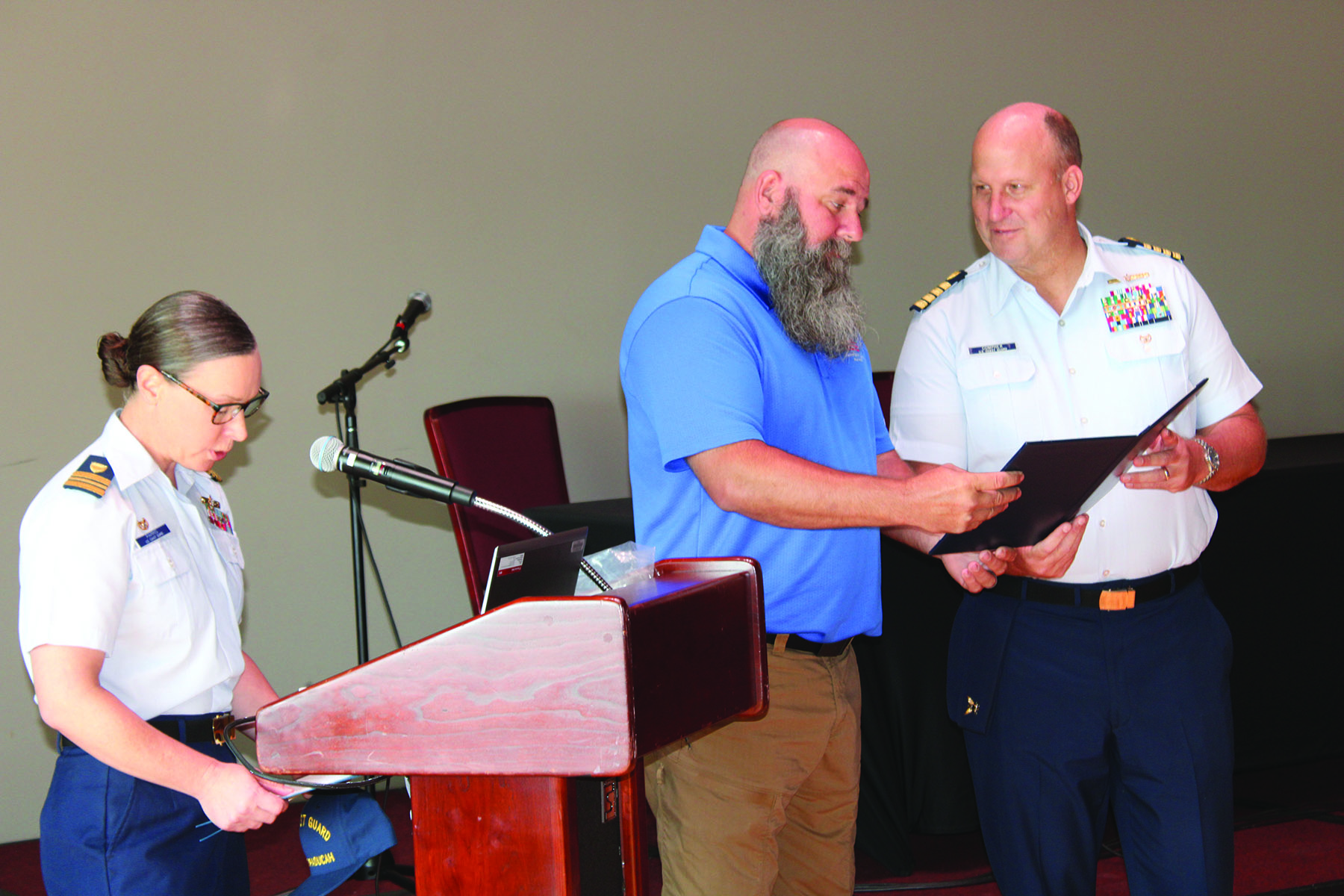The third annual Marine Compliance Alliance workshop August 6-8 drew a record crowd of about 120 people, who learned about drydock availability, Subchapter M compliance, marine casualties and proposed drug-testing policies, among other subjects.
The workshop, held at the Carson Center in Paducah, Ky., rotates annually between Paducah and New Orleans. It began with a surprise Coast Guard certificate of merit presentation to Josef Vlach, vice president for compliance and emergency management for James Marine Inc., and ended with an optional two days of ABS root cause training.
Capt. Robert Compher, the new chief of the traveling inspection office at Coast Guard headquarters, and Lt. Cmdr. Terri Parris, commander of the Towing Vessel National Center of Expertise (TVNCOE), located in Paducah, presented Vlach with the certificate of merit “for exemplary commitment to public service in support of the Coast Guard’s safety mission,” Parris said.
Paris noted that Vlach has participated in every formal TVNCOE-sponsored training offered since 2018, which assisted in the qualification of more than 100 marine safety professionals. Parris called Vlach an invaluable asset to the TVNCOE, the Coast Guard and the towing industry at large.
Following the presentation, Capt. Alan Moore, chief of prevention for the Eighth District, welcomed attendees and discussed plans for releasing an inland repair guide to industry and continuing to work on renewal expectations and consistency for Certificates of Inspection (COIs).
Shipyard Availability Panel
Bill Foster of McGinnis, Scott Meier of Wepfer Marine, Barry Gipson of James Marine, and Geoff Scibek of the Coast Guard’s Huntington Marine Safety Unit teamed up for a shipyard availability-focused panel, with Vlach moderating.
Foster noted that a concern of the shipyard community is that companies may have postponed credit drydock exams and internal structural exams required under Subchapter M for vessels needing the most work until near the time their COIs are due to expire.
“As we’ve gotten later in this, we’ve seen some of the older, more intensive ISEs to be done, so we’ve seen completion taking a little bit longer,” he said.
Foster said shipyards are recruiting welders constantly and that the workforce has rebounded a bit from lows associated with COVID-19. Still, the available workforce in a shipyard can be a limitation for companies trying to complete extensive work on a vessel as quickly as possible.
When possible, Foster said it is a good idea to give shipyards at least three months’ notice when repairs are needed.
Gipson said James Marine employs more than 1,200 workers in shipyards. To aid expediency, some shipyards, including those in the Paducah and New Orleans areas, are primarily focusing on vessels’ internal structural exams (ISEs). Others, like those in Wickliffe, Ky., and Hahnville, La., are available to conduct ISEs but are also focusing on other types of repairs.
“We have capacity,” Gipson said. “We’ve done over 100 ISEs last year. We’ve done 70 so far this year.”
Meier suggested that vessel owners have a surveyor look at their boats before scheduling drydock time to have a good idea of what work is needed and how long it might take. He gave an example of one company that scheduled a week in the drydock for repairs that ended up taking six weeks because of unfamiliarity with Subchapter M requirements.
“We want to know what you’re going to do because if we think you’re coming in for a week or two weeks, and it turns into six or 10, that’s tough on both sides,” Gipson said. “There are always going to be changes. We know that, but if you have the bulk of that lined up with the shipyard, they’ll know the manpower requirements and how to get that scheduled, and they’ll be able to turn that around as quickly as they can.”
Panelists agreed that long lead times on many of the parts and supplies shipyards most commonly need have lessened since the height of the COVID-19 pandemic.
“Of course, if you’re trying to order something the week of [needing it], you might be in trouble,” Foster said.
Audience members also asked panelists about the impact of using internal tank coatings in vessels, with Foster saying he has seen several companies use coatings to try to preserve the life of the steel. Vessels with internal coatings from the beginning aren’t needing as much work, Foster said.
Panelists also said the scope of work required as part of Subchapter M is becoming more consistent, both among TPOs and Coast Guard districts.
Scibeck said the Coast Guard will walk companies through the Subchapter M process at a captains meeting, if invited. The Coast Guard is still seeing issues with companies not providing enough documentation, Scibeck said. He encouraged companies to include photos and even videos to better explain the scope of repair work.
Subchapter M Compliance Trends
Cmdr. Dan Kilcullen, chief of domestic vessel and offshore compliance for the Coast Guard, provided updated statistics on the towing vessel fleet. As of July, there were 5,065 active towing vessels, 65 inactive, 1,333 laid up and 243 scrapped, destroyed, abandoned or sunk for a total of 6,706 vessels. Of those, 68 percent had taken the Towing Safety Management System (TSMS) option using a TPO, and 32 percent were inspected by the Coast Guard.

Eighth District chief of prevention Capt. Alan Moore welcomes those attending the third annual Marine Compliance Alliance Workshop Aug. 6-8 in Paducah, Ky.
According to Kilcullen, the Coast Guard projects 347 Coast Guard-inspected vessels and 794 TSMS-option vessels to have COI inspections in 2025. That number is expected to decrease slightly in 2026, with additional reductions in 2027 and 2028.
“In 2025 there are going to be a lot of people pushing for drydock space,” he said.
Kilcullen also showed a chart of towing vessel detentions per year since 2018. As of July there had been nine vessel detentions this year in District 8, which comprises most of the country’s inland river system. Of the vessels detained, six of those were using the Coast Guard option.
In all of 2023, 17 vessels were detained in all Coast Guard districts, with 10 of those using the TSMS option and the remaining seven the Coast Guard-inspected option, Kilcullen said. Thirteen of the 2023 detentions were from District 8. That was the first year TSMS-option vessels had more detentions than those inspected by the Coast Guard.
Since 2018, there have been 137 towing vessel detentions in District 8.
So far in 2024, structural issues (19) have been the top deficiencies on detained vessels, Kilcullen said, followed by fire safety (11) and propulsion and auxiliary machinery (9). Some detained vessels had multiple system deficiencies.
TPO Oversight Panel
Marquette Transportation’s Brian Khey then moderated a TPO panel discussion, which featured Tava Foret of the Towing Vessel Inspection Bureau, Dale Metcalf of Coast Guard Sector Upper Mississippi River, Dave Phillips of TVNCOE, and John Quandt of the Coast Guard Office of Vessel Compliance.
Metcalf said that companies that are proactive and doing a lot of steel work are taking some time in drydock, and that it is important to allow enough time to complete the work before a vessel’s COI expires.

Josef Vlach, vice president for compliance and emergency management for James Marine, introduces members of the Shipyard Availability Panel. They are (left to right): Geoff Scibek of the Coast Guard’s Huntington Marine Safety Unit, Bill Foster of McGinnis, Barry Gipson of James Marine and Scott Meier of Wepfer Marine. Vlach moderated the panel.
When it appears likely that a COI might expire while still in drydock, “There is a lot of stuff that can be done beforehand, but afterward our hands are getting tied,” he said.
When speaking specifically about major nonconformities, Quandt said to watch out for missing dates on paperwork.
Phillips said as companies get more familiar with Subchapter M, COI renewals are going more smoothly.
“There have been some bumps in the road, but everybody’s making improvements,” he said.
Foret said follow-on cycles for COI renewals should include more abbreviated work since documentation will exist showing a vessel’s condition from its previous inspection. Phillips agreed, saying that current inspections and exams are sometimes repairing 30 or 40 years of damage.
“The next time around we won’t have all of that to do,” he said.
Marine Casualty Trends
Cmdr. Kelli Dougherty of the Coast Guard Office of Investigations discussed trends for both industry marine casualties and sexual abuse and sexual harassment reporting.
The three leading causes of accidents with crewmember fatalities were falls into the water, asphyxiation and crushing injuries, she said.
“Three of the four fatalities this year were one of those kinds of accidents,” she said.
The towing industry crewmember fatality rate averages 3.3 per year, much lower than the Bureau of Labor Statistics’ rate of 14.1 annually among all transportation sector fatal work injuries and more in line with the BLS average of 3.7 annually among all workers, Dougherty said.
She also noted that the latest data available, from 2022, indicated 5,799 gallons of oil had been spilled into navigable waterways as a result of 36 tank barge incidents, a figure that has remained relatively steady in recent years.
Regarding sexual assault, harassment and sexual harassment reporting, Dougherty said there has been “a signifiant influx” of previously unreported misconduct cases, along with new ones, since passage of the Safer Seas Act of 2022. While the initial delay between an event under investigation taking place and its reporting date averaged 450 days, the Coast Guard is now getting those reports within a few weeks typically.
According to Dougherty, since the passing of the act, the Coast Guard has investigated 176 harassment cases, 162 sexual harassment cases, 23 assault cases and 91 sexual assault cases and has received notice of 78 felony sexual assault cases from the Transportation Security Administration’s Record of Arrest and Prosecution Background (Rapback) program, which includes reports of new felony sexual assault convictions by those with maritime credentials, even if they were not in a maritime setting.
Drug Testing Policies
Patrick Mannion, the Coast Guard’s Office of Investigations and Analysis Drug and Alcohol Prevention and Inspection Program manager, said the U.S. Drug Enforcement Administration has issued a proposed rule to reschedule marijuana from a Schedule 1 drug (of no pharmacological value) to a Scheduled 3 drug (a controlled substance allowed with a medical prescription).
“This is a significant potential change,” Mannion said.
The proposed rulemaking received 12,000 comments during the comment period.
“As of now, we have been informed that the Department of Justice is continuing to push forward with this and would like to publish before the end of the calendar year,” Mannion said. “That’s pretty optimistic with the number of comments received, but it is possible.”
While the Department of Transportation has allowed oral fluid (saliva) testing to detect marijuana use, it “put the cart before the horse,” Mannion said.
The issue, Mannion said, is that DOT must follow HHS procedures, and no laboratory has created an oral fluid testing device that meets all applicable standards. Even if such a test is developed, there is a question whether such a test would also meet U.S. Coast Guard testing requirements for post-casualty investigations, Mannion said.
Mannion said there is also discussion of widening the HHS/DOT drugs of abuse testing panel to better capture synthetic drug use.



